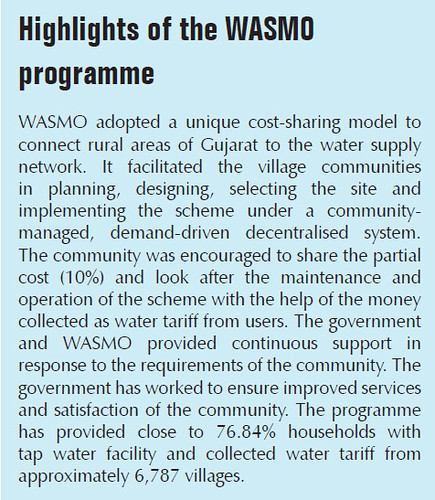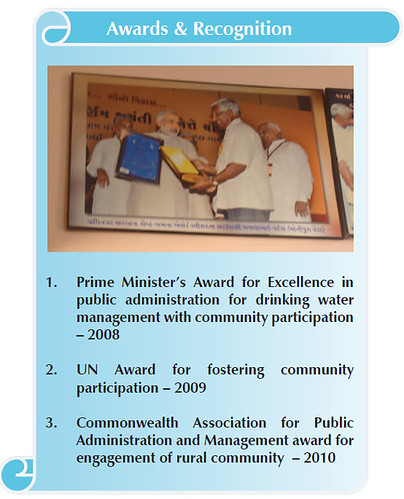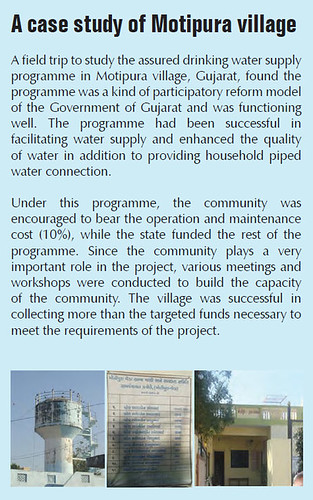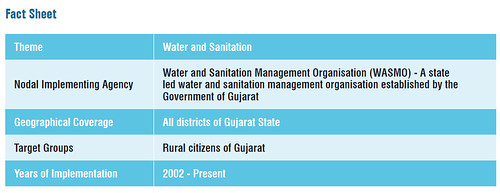Source
Social Sector Service Delivery Good Practices Resource Book 2015, NITI Aayog Government of India
The state-led Water and Sanitation Management Organisation (WASMO) has successfully implemented a unique rural water supply programme to ensure adequate, quality drinking water supply at an affordable cost in all rural areas of Gujarat. The programme is distinctive because the State government has adopted a demand-responsive adaptable approach involving strong community participation. The programme is based on a unique cost-sharing model, where the community partially shares the cost, owns the drinking water assets and holds the operation and maintenance responsibilities. It has successfully brought drinking water supply to the doorstep of rural Gujarat while establishing a financially sustainable water system.
Rationale
Diverse geological, hydrological, climatic and soil conditions adversely affect the surface and groundwater resources in Gujarat. As much of the state lies in a scarcity-prone area, it faced a wide range of water related problems, such as drying up of sources, recurrent droughts, repeated failure of tube wells, water quality issues, mass migration of humans and cattle, drudgery of fetching water from long distances and waterborne diseases. Excessive fluoride and nitrate content affected the water quality in many districts of the State. Water supply, too, was erratic, and there were no fixed hours for water supply, which would run for two to threehours daily. This scenario compelled residents to use water from tankers and bore-wells. This state of affairs has contributed to migration from the State, livelihood insecurity and health problems.
 The persistent and pervasive scarcity of potable water necessitated augmentation of Gujarat’s water supply system. Aiming to replenish water resources in Gujarat and achieve sustainability in rural water supply, the Government of Gujarat established an autonomousorganisation known as WASMO in 2002. WASMO was tasked with facilitating a community-managed water supply programme in all 26 districts of the State.
The persistent and pervasive scarcity of potable water necessitated augmentation of Gujarat’s water supply system. Aiming to replenish water resources in Gujarat and achieve sustainability in rural water supply, the Government of Gujarat established an autonomousorganisation known as WASMO in 2002. WASMO was tasked with facilitating a community-managed water supply programme in all 26 districts of the State.WASMO took a demand-driven decentralised approach and worked closely with the village communities and their representatives to identify needs and design the programme and its implementation process. While the village community contributed to the planning, implementation and maintenance of the village water supply system, the government took up the responsibility for policy formulation, monitoring and evaluation and financial support.
Objectives
Gujarat’s rural water supply programme aims to supply the village community with adequate, regular and safe water through household-level tap water connectivity, including households of persons from backward communities. The programme strives to build a sustainable model through capacity building of village communities and empowering them to manage waterresources themselves.
Key Stakeholders
The village community, working through its 18,185 Pani Samitis (local water committees) spread across the state, is involved in the planning, implementation, arrangement, operation and maintenance of the village water supply system in 18,185 out of 18,478 villages of Gujarat. The village community provides 10% of the funds for the programme.
About 75 Non-Governmental Organisations (NGOs) are actively involved in the programme and extend support to the village communities in planning and executing work. International organisations such as the United Nations Children’s Fund (UNICEF), Water Sanitation and Hygiene (WASH) and the World Bank are extensively involved in awareness generation and capacity building initiatives for all stakeholders of the programme.
 WASMO, Government of Gujarat, provides technical assistance and guidance and extends necessary financial support by contributing 90% of the funds.
WASMO, Government of Gujarat, provides technical assistance and guidance and extends necessary financial support by contributing 90% of the funds.Implementation Strategy
WASMO adopted a community-managed, demand driven, decentralised approach for the rural water supply programme. The programme has been implemented in three cycles. The first cycle, lasting three to six months, involved mobilising the community; the second cycleinvolved execution and completion of the project, which takes 12 months; and the third cycle is the post implementation and follow-up phase, lasting 12 months as shown in Figure 2.
In the first cycle, the programme is introduced at the village level as an initiative for providing adequate and safe water supply to the village community. The community is askedto share its concerns so as to seek an appropriate solution for water and sanitation-related problems. Meetings and workshops are organised to bring awareness about thecomponents of the programme, including community participation and the concept of cost-sharing. Since the programme requires the community to contribute 10% of the cost, the community’s participation and a sense of ownership are automatically built-in from thebeginning. These processes of interaction are facilitated by NGOs and there is a strong emphasis on community contribution for structures and assets so that every member can share views on implementation, check accounts and procedures, and play a role in ensuring that quality equitable systems are put in place.
The collaborative institutional framework bringing together NGOs, WASMO and other public authorities is an inherent feature of the programme, reflecting WASMO’s recognition of the importance of involving various stakeholders. NGOs also play a significant role in handling social issues. For example, they ensure the involvement of Dalits and the representation of women in the Pani Samitis. Most importantly, they play an important role in bringing about the initial agreement on the issue of the community’s contribution to the tariff.
 WASMO, based on their assessment of requirements to address water issues expressed by the village community, calculates the amount required for programme implementation in each village. 10% of this sum is then collected from residents of the village as their contribution (to which WASMO adds the remaining 90%), after which WASMO and the concerned implementing agency develop the Village Action Plan (VAP) with the communitythrough Participatory Rurual Appraisal (PRA).
WASMO, based on their assessment of requirements to address water issues expressed by the village community, calculates the amount required for programme implementation in each village. 10% of this sum is then collected from residents of the village as their contribution (to which WASMO adds the remaining 90%), after which WASMO and the concerned implementing agency develop the Village Action Plan (VAP) with the communitythrough Participatory Rurual Appraisal (PRA).VAP is a structured plan prepared by the community and carries details of the work to be done at the community level. The VAP reflects the needs and concerns of the local people with the objective of providing clean drinking water to everyone in the village, including the deprived and weaker sections. Once the VAP is approved by the Gram Sabha, the Pani Samiti is given the responsibility of planning and implementing the programme to suit theirneeds and requirements.
The second cycle involves formation of a Pani Samiti, which is headed by the Sarpanch and consists of 10-12 members. As the programme takes a community managed approach, these Pani Samitis manage planning and implementation of the water supply programme within the village, and handle programme funds at the village level, which they maintain in a separate bank account. This account contains funds transferred by WASMO as well as funds generated by the water tariff collected by the Pani Samitis from village households.
A logo of WASMO on programme assets and infrastructure prevents misappropriation of the structures created. For all structures costing over Rs 25,000, details of the sanctioned cost, actual cost, completion date and name of implementing agency are announced.
At the end of this process, it is ensured that community gets access to safe and regular water. A comprehensive Information, Education and Communication (IEC) campaign including publications, folk media, electronic media, rallies, campaigns and workshopsis undertaken to promote responsible water use and water conservation. In addition, capacity building for monitoring and supervision is undertaken to ensure that the community takes charge of implementation, sustainability and maintenance of the scheme. It looksafter collection of water tariff, delivery of water in the villages, testing of water quality and ensuring proper utilisation of resources at the village level.
The third cycle after the project involves hand-holding of the Pani Samitis through the year to ensure that programme efforts are sustained. This involves financial as well as technical trainings and building their rapport with the district and block centres besides interaction withother Pani Samitis.
The handholding process ensures Pani Samitis are eventually capable to independently run, manage and sustain the benefits of the earlier two cycles so that the community has access to safe and regular water. The IEC and capacity building activities that were undertaken in the previous two cycles enable the community to cooperate effectively with the Pani Samitis after the exit of WASMO and its partner organisations.
The Pani Samiti proposes a water and sanitation tariff to the users in a clear, logical and transparent manner, taking into account the costs of operation and maintenance, depreciation costs of hardware, contingency funds and the tariff to be paid to the government agency for supplying water. The Pani Samiti also decides the frequency of collection and if the tariff is calculated per household or per person. The Pani Samiti then presents the proposed tariff to the Gram Sabha for approval.

Resources Utilised
The rural water supply initiative in Gujarat is a community managed programme where 90% of the funds are provided by the state-supported organisation WASMO, and 10% of the funds come from the village community. Funds contributed by the community are returned once the programme is implemented. An estimated amount of Rs. 800 crore has been spent on infrastructure development for ensuring water supply in villages (including the contribution of the village communities). The responsibility for maintenance and operation of the system is borne by the village community. Approximately 6,787 villages collect water tariff from users to ensure financial sustainability of the programme.
WASMO has also provided all the technical assistance and guidance required and built the capacity of the community to handle the programme. The entire programme was driven by augmenting internal human resource capacities. Pani Samitis were provided training on construction, management and operation. Training was also imparted to the community on a wide array of subjects, from programme planning to post implementation operation and maintenance. Workshops were conducted to help them in maintaining records, documents, bank accounts etc.
Impact
Financially sustainable system of providing clean water to rural households: The programme has successfully met its objective of bringing drinking water supply to the doorstep of rural Gujarat. WASMO has established a financially sustainable model for water provision that is successful in providing reliable, efficient and regular operations, by facilitating the development of in village water supply systems. The programme has beensuccessful in maintaining good quality of water, providing household-level tap water connection and promoting sustainable use of water resources.
 High coverage of villages in Gujarat: The rural water supply project is providing high quality, potable drinking water to all the 26 districts of Gujarat through a community-managed water supply system. As of December 2013, approximately 9,809 village schemes have been completed at an investment of Rs. 800 crore; work is under progress in 3,310 more communities; and 76.84% households have access to safe tap water. Some of the other major achievements of the programme so far have been formation of Pani Samitis in about 18,185 out of 18,478 villages in the state; formation of water quality teams in 16,860 villages; distribution of field test kits in 14,216 villages; and fixing and collecting water tariff by 7,131 villages.
High coverage of villages in Gujarat: The rural water supply project is providing high quality, potable drinking water to all the 26 districts of Gujarat through a community-managed water supply system. As of December 2013, approximately 9,809 village schemes have been completed at an investment of Rs. 800 crore; work is under progress in 3,310 more communities; and 76.84% households have access to safe tap water. Some of the other major achievements of the programme so far have been formation of Pani Samitis in about 18,185 out of 18,478 villages in the state; formation of water quality teams in 16,860 villages; distribution of field test kits in 14,216 villages; and fixing and collecting water tariff by 7,131 villages. Incentives to Pani Samitis through awards: WASMO is playing a crucial role in strengthening the community’s capacity for managing water supply services efficiently and adequately. To encourage this, WASMO has introduced a Pani Samiti award. The decentralised participatory approach is one of the major reasons for the success of the water supply programme in Gujarat. The process of planning and implementation has also been inclusive, given the active participation of the people, the community, NGOs and other stakeholders.
Incentives to Pani Samitis through awards: WASMO is playing a crucial role in strengthening the community’s capacity for managing water supply services efficiently and adequately. To encourage this, WASMO has introduced a Pani Samiti award. The decentralised participatory approach is one of the major reasons for the success of the water supply programme in Gujarat. The process of planning and implementation has also been inclusive, given the active participation of the people, the community, NGOs and other stakeholders.Human development benefits: The safe and adequate water supply has brought about a significant improvement in the human development index through increased opportunities, especially for girls, to continue their education instead of fetching water from long distances; reduction in waterborne diseases; better sanitation facilities; improved overall health status and better living standards of the local community.
Key Challenges
The programme has performed very well in almost all the districts of the State. It did, however, face challenges from time to time, such as capacity-related issues in adapting to new changes, administrative challenges, issues in standardisation of relevant information and inadequate coordination between the community and the implementing agency.
 Adding to these challenges were the other problems including difficulties in reaching remote locations, lack of support from the community or other stakeholders involved in the project and other social constraints.
Adding to these challenges were the other problems including difficulties in reaching remote locations, lack of support from the community or other stakeholders involved in the project and other social constraints.The community’s interest and participation were seen to differ from site to site. People’s participation at different stages of the programme is important as it builds community ownership, enhances the performance of the community and ensures effective implementation of the programme.
Replicability and Sustainability
The strength of the programme lies in its strategy of establishing a demand-driven community-managed water supply system. The Government of Gujarat has managed to perform exceptionally well in engaging the community in this programme. After receiving financial assistance from the Government of India for 13 districts, the programme was later scaled up to other remaining 13 districts by the Government of Gujarat.
 Financial assistance was received during 2008-09 in the shape of budgetary provisions of the Accelerated Rural Water Supply Programme (ARWSP) for taking up rural water supply schemes.
Financial assistance was received during 2008-09 in the shape of budgetary provisions of the Accelerated Rural Water Supply Programme (ARWSP) for taking up rural water supply schemes.For sustainability of the programme, people of the village must be involved in its implementation and participate at every level of planning. Over time, the programme has received high participation from Pani Samitis and the community in planning, execution andmaintenance of the village water supply system.
As of December 2013, approximately 3,790 villages have managed to run the system efficiently and effectively without any government support. Equitable access to water resources, including for backward and deprived sections of the population, is a significantaspect of the programme. By engaging the community and the Pani Samitis in the implementation process, the programme has managed to provide equal benefits tothe community, thereby ensuring social sustainability of the programme.
Conclusion
The programme has been a successful and pioneering initiative in providing assured drinking water supply in all the rural areas of Gujarat. WASMO has collaborated withcommunities and employed the existing infrastructure to ensure that people have adequate, regular, safe, sustainable and convenient water supply at their doorsteps. In the coming time, the programme aims to also enhance sanitation facilities at the household level.



